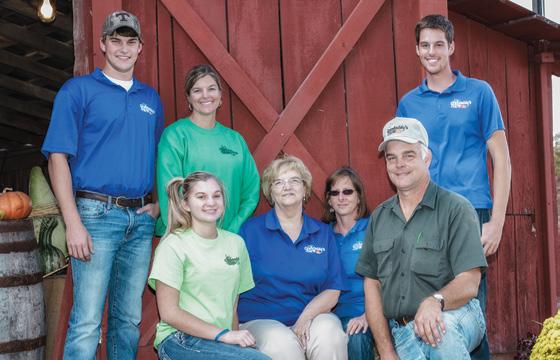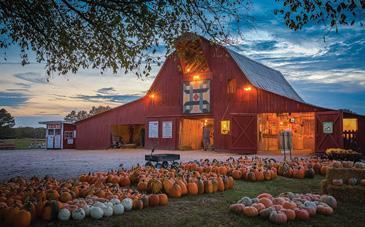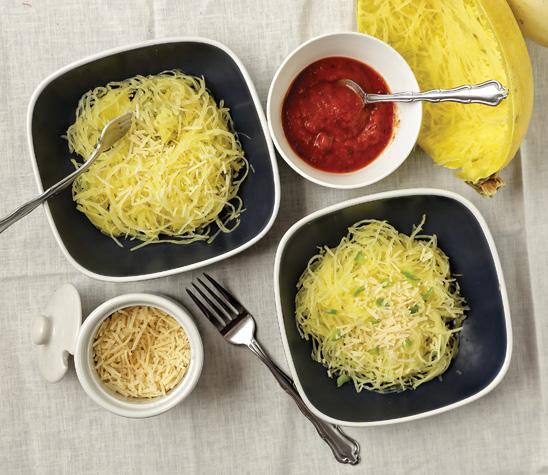
4 minute read
Fall Squash
Fall squash
Enjoy a versatile, beautiful taste of the season
Trees tower over the two-lane road, its dividing line faded with wear and age. As you approach Grandaddy’s Farm, however, the road widens and a rainbow of colors appears in hues of the autumn season — orange pumpkins, gourds of green, golden butternuts and the reddish tinge of One Too Manys.
“The farm is beautiful in the fall,” says Andrew Dixon, who lives on the property once owned by his grandfather, Charles Dixon. “The fields are dying back and giving way to the colors of all the different winter squash varieties.”
Hayrides are one of the most popular activities the Estill Springs, Tennessee, farm offers, taking families afield to pick the perfect pumpkin. Since the Dixon family became involved in agritourism, this is one of several things visitors can now do to learn more about farm life and growing in the Volunteer State.
But offering pumpkins and winter squashes for decorating is just one thing Grandaddy’s Farm does. The Dixons also encourage folks to cook with them by offering free recipes at the farm store. “You can use them as table decorations, and then you can turn around and use the same ones for cooking, so you’re not throwing it away,” Dixon says, adding that it’s only been in the past six or seven years that he’s seen more people in the South interested in cooking with winter squashes.

Grandaddy’s Farm is made possible with the help of family, including, from left, Philip Dixon, Ann Thomas, Lacey Thomas, Nancy Dixon, Karen Dixon, Steve Dixon and Andrew Dixon.
“Before that, it was more of a Northern thing,” he says. “It’s taken us a little longer when the only squash we grew up with was yellow squash — and we fried that.”
The farm offers 15 varieties of squash and gourds. Winter squash planting takes place in late June. Harvest begins in early September, and the farm opens to the public later that month on Fridays from 1:30-9 p.m. and Saturdays from 9 a.m.-9 p.m.
Dixon’s personal favorite squash is butternut, a versatile variety that can be used in place of pumpkins for pies. “Butternut squash is so much easier to use,” he says. “Pumpkins have so many seeds and stuff. There’s so much to hollow out. A butternut squash is all meat. It’s much more efficient to cook with.”
Butternut squash is also a good choice in casseroles, smoothies, soups and salads. “Any winter squash can be used for cooking, but some are better than others,” Dixon says.
Here are some recipes from Grandaddy’s Farm.

GRANDADDY’S FARM SPEEDY SPAGHETTI SQUASH
1 spaghetti squash
Butter
Parmesan cheese
Wash squash and place it on a cutting board. Cut squash in half lengthwise and scoop out seeds. Place squash halves cutside down on a plate with a little water in the bottom and microwave on high 5-8 minutes or until tender. Fluff the insides of the squash with a fork, and it will begin to resemble spaghetti. Place “noodles” on a plate and top with butter and parmesan cheese to taste.

Note: Meat sauce also goes well over the squash noodles, and the noodles go well in a mock pasta salad with the addition of zesty Italian dressing and your favorite pasta salad ingredients (onions, green pepper, hard salami, capers, etc.).
APPLE-STUFFED ACORN SQUASH
2 apples, peeled and cut into slices
2-3 tablespoons butter, melted
1 acorn squash
Honey
Add apple slices to frying pan with melted butter. Saute apples until fork tender. Set aside.
Place squash on cutting board, slice it in half lengthwise and scoop out seeds. Place halves cut-side down on a plate with a little water in the bottom. Microwave on high for 3-6 minutes until the inside is tender.
PUMPKIN (SQUASH) PUREE
1 large butternut squash
Wash squash and place it whole in an ovenproof pan. Roast squash at 350 F for 1 to 1 1/2 hours or until you can insert a fork easily into the squash. Remove squash from oven and let cool. Slice the squash lengthwise and scoop seeds out gently, taking care to leave the meat intact. Scoop out all of the meat, place it in a blender or food processor, and puree until smooth. Use the puree as the base for pumpkin pie, smoothies or any other recipe that calls for pumpkin.
Tip: You can freeze the puree for several months. At Grandaddy’s Farm, the Dixons freeze puree in quart bags in the amount called for in their recipes, and they thaw it as needed.
‘PUMPKIN’ PUREE SMOOTHIE
1 frozen banana
1/2 cup vanilla Greek yogurt
1/4 teaspoon ground cinnamon
1/4 teaspoon pumpkin pie spice
1/2 cup skim milk
2 tablespoons pure maple syrup 2
/3 cup butternut squash puree
1 cup ice
Add all of the ingredients to a blender in the order listed. Blend on high for at least 3 minutes or until smooth. This may take longer if your blender isn’t very strong. Scrape down the sides of the blender as needed. Add more milk to thin out if the mixture is too thick. Add a couple more ice cubes for a thicker texture if desired. Add more spices to taste, if desired. Makes 1 smoothie.
FOOD EDITOR ANNE P. BRALY IS A NATIVE OF CHATTANOOGA, TENNESSEE.








